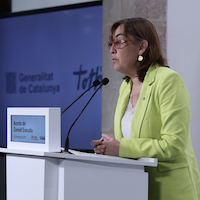news
CIMNE, member of the new Spanish Research Network for Cardiac Computational Modelling
 The International Centre for Numerical Methods in Engineering (CIMNE) is one the promoters of the network V-Heart SN. This network, composed by a total of nine universities and research centres, is intended to make the use of virtual hearts easier by employing computational models in daily clinical practice, which will allow doctors to design personalized and more effective and safer therapies.
The International Centre for Numerical Methods in Engineering (CIMNE) is one the promoters of the network V-Heart SN. This network, composed by a total of nine universities and research centres, is intended to make the use of virtual hearts easier by employing computational models in daily clinical practice, which will allow doctors to design personalized and more effective and safer therapies.
In the Spanish Research Network for Cardiac Computational Modelling participate the Universitat Politècnica de València, the Universidad de Navarra, the Universitat de València, the Universitat Politècnica de Catalunya, the Basque Center for Applied Mathematics, the CIMNE, the Universitat Pompeu Fabra, the Barcelona Supercomputing Center and the Universidad de Zaragoza.
Therefore, the network brings together expert researchers simulating the functioning of the heart from different points of view: electrophysiological and biomechanical, as well as those of major experts in numerical methods and high performance computation.
"V-Heart SN is the first Spanish network in this field. We aim to improve the computational models in the cardiac field and ultimately improve the clinical practice with this research work. To do this, we are working on the development of a virtual heart able to be adapted to the characteristics of each patient and to be used for both medical professionals and med-tech companies", explain the promoters of this network, the first with these characteristics in Spain.
The development of this computational model of the heart will give a better understanding of the mechanisms that generate and maintain the cardiac arrhythmias. It will allow doctors to optimize the application of therapies (cardiac resynchronization, defibrillation, pacemakers, etc.,) and to predict the effectiveness of drugs and their cardiotoxicity. “We will contribute to the use of computational modelling in the daily clinical practice thanks to the development of tools adapted to the final user, the medical professional”, add the researchers of V-Heart SN.
The biomechanics engineering team of CIMNE, leaded by the Dr. Eduardo Soudah, will provide to the network high performance computational models developed under the KRATOS open-source development environment to better understand the hemodynamics of the cardiovascular system. The objective is to provide complementary information to physicians when it comes to improving the diagnosis of different cardiovascular pathologies through the use of computational multiphysics models. The CIMNE team will focus on the computational hemodynamic part, specifically, in the calculation of the Fractional Flow Reserve (FFR) for the diagnosis of coronary diseases and in a software of analysis and image processing resonance (MRI) of 4D phase contrast.
The network will work on searching for new computing solutions for the challenges of clinical research in the cardiovascular field, and aims to become a national and international reference point in the area of cardiac modelling, and to strengthen the position of the Spanish science in this field.
In the media: La Vanguardia | Diario Médico | Aldia.cat | Redacción Médica | Heraldo




















